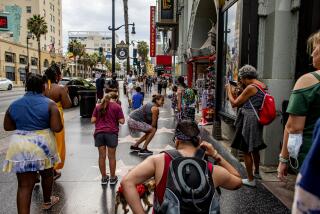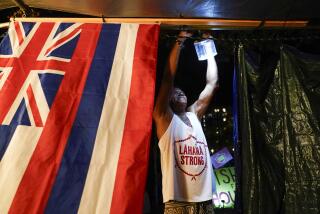Hawaii is far from an economic paradise
Reporting from Kailua-Kona, Hawaii — Between dealing with terrorism threats and crises abroad, President Obama is unwinding in Hawaii with his family this week. They’ve snorkeled in pristine bays and dined in fashionable restaurants. Tourism officials only wish there were thousands more visitors like them.
Tourism is the glue that holds this island state’s finances together, keeping its streets clean, its workers paid and its children educated. But for the last two years, vacationers and conventioneers alike have abandoned Hawaii in favor of less exotic destinations closer to home. The result is an unprecedented slowdown in the industry and some cavernous cracks in the state’s budget.
Hawaii was so short of cash last year that it furloughed teachers and suspended school for 17 Fridays during the academic year, giving students the fewest school days of any state in the union. Home foreclosures and bankruptcy filings are soaring. The unemployment rate has more than doubled over the last two years to 7.0%. Though that’s well below the national average of 10.0%, it’s a stunner for a place that just a few years ago boasted a jobless rate of less than 3%.
For the first time in a decade, the number of Hawaiians receiving welfare benefits has increased. Crime is up on the island of Oahu this year, even as it fell nationwide. And as if things weren’t discouraging enough, an army of rats in Honolulu’s Chinatown is afflicting the already beleaguered restaurant trade.
It’s the “worst recession in our lifetimes,” said Marcus Oshiro, chairman of the state House Finance Committee.
The number of visitors to the islands in November fell 17% from 2007, and total spending by air visitors for the first 11 months of 2009 decreased $1.3 billion from the same period in 2008.
Tourism officials are hoping that the Obamas’ visit can begin to turn that around, with images of sugary beaches and 30-foot waves being beamed back to mainlanders.
“We believe that having images of Hawaii in the media -- especially now when it’s 20 degrees below in some places -- can only put the desire for a Hawaii vacation in future travelers’ minds,” said Marsha Wienert, tourism liaison for the state.
But some Aloha State natives are blaming Obama, a Hawaii native, for at least part of the slump. They say he didn’t do them any favors last year when he said firms receiving government bailouts shouldn’t be taking trips “to Las Vegas or go down to the Super Bowl.” He might as well have said Hawaii.
Lavish conventions and corporate junkets have come under fire since it was revealed that troubled insurer American International Group Inc. spent $443,000 at the St. Regis Resort in Dana Point just days after accepting an $85-billion federal bailout. The backlash has cost luxury destinations such as Hawaii a bundle. More than 100 corporations and associations scrapped Hawaiian conferences or business retreats after Obama’s comments, according to Hawaii’s Department of Business, Economic Development and Tourism.
“We’re losing the group business that’s either canceled due to economic reasons or concerns about being seen as a company going to Hawaii,” said Keith Vieira, senior vice president and director of operations for Starwood Hotels & Resorts in Hawaii and French Polynesia.
Some Hawaiians are underwhelmed by the return of their native son. In the scruffy town of Wahiawa on Oahu, far from the beaches and fancy hotels, some locals waiting by a pawnshop for the bus were decidedly ambivalent about the president.
“It’s not good here -- there are no jobs,” said Hu Toelupe, who said she didn’t expect to see the president and didn’t care if she missed him.
The drop in jobs has especially hurt Hawaii’s Big Island, which traditionally feels a slowdown first and recovers last as opposed to Oahu, the most populated island, said Joseph Toy, president of Hawaii tourism research firm Hospitality Advisors. In November, hotel occupancy on the Big Island was a meager 40%, he said.
Occupancy at hotels on the Big Island and Kauai fell to 54% from 72% and to 60% from 78%, respectively, over the last three years, says TZ Economics, a local research firm. The drop in hotel revenue exceeds $1 billion across the state, according to some estimates.
On a recent sunny afternoon at Uncle Billy’s Kona Bay Hotel on the Big Island, only cats scurried around the manicured grounds. The balconies and outdoor restaurant were deserted. A lone woman sat smoking by the circular pool.
Across the street at the Kona Inn Shopping Village, a jewelry store, tour operator and an arcade called the Fun Factory were all closed, padlocks on their doors.
“It’s never been this slow in 25 years,” said Patrick McFeeley, a photographer who owns the Picture Store, which sells photos of giant waves, lava flows, palm trees and other iconic Hawaiian images from a shop overlooking the sea.
There’s hardly a tourist spot on the planet that hasn’t been hurt by the global slowdown. But Hawaii has proved particularly vulnerable. Situated 2,900 miles off the West Coast, it’s dependent on air travelers and cruise ship passengers at a time when many nervous consumers are contenting themselves with “staycations.”
The tourism decline here accelerated in early 2008, as the U.S. economy faltered and employers axed tens of thousands of workers. Suddenly, a tropical vacation became an unthinkable luxury to many consumers. In April of that year, Aloha Airlines and ATA Airlines closed, cutting the number of airplane seats coming to Hawaii by 15%, said Wienert, the tourism liaison. Then two cruise lines redeployed ships to other ports of call.
“We’ve gone through two years of huge declines in our tourism industry, which has resulted in huge declines in revenue for Hawaii business and government,” Wienert said.
A number of ritzy hotels are in foreclosure or have changed hands because of financial difficulties. Shops around the upscale areas are feeling the slowdown too.
“Usually at Christmastime, you couldn’t walk through the mall, it was so crowded,” said Dion DeBois, who works at a jewelry store at the upmarket Kings’ Shops at Waikoloa Village, about 30 miles north of Kailua-Kona. “Now, nobody’s traveling,” he said, glancing outside, where a man with a guitar sang to a row of empty plastic chairs.
That’s made Hawaii, which is trying to close a $1.2-billion budget shortfall, eager to find new sources of income. Green power is at the top of the list, said Russell Pang, a spokesman for Gov. Linda Lingle. The state has pledged to obtain 70% of its energy from renewable sources by 2030. It’s trying to lure entrepreneurs to make the state a hotbed of clean technology and homegrown power.
And many here are thrilled that a consortium of universities has chosen Hawaii as the site for the world’s biggest telescope, which could spawn construction and research jobs.
But there’s nothing on the horizon to replace tourism any time soon. Even though signs are emerging that more Americans will start traveling again in 2010, some Hawaiians are giving up on paradise for good. In 2009, more residents left Hawaii than moved here for the first time in a decade, according to census data.
Sonia Grimme, co-owner of Surf and Sand, a beachwear shop on the Big Island, is thinking about moving back to her native Taiwan with her husband and 12-year-old son. She’s worried that her son isn’t getting the education he needs in Hawaii; he now stays home and plays video games on furlough Fridays.
“The system is broken here,” she said. “He can get a much better education in Taiwan.”
More to Read
Sign up for The Wild
We’ll help you find the best places to hike, bike and run, as well as the perfect silent spots for meditation and yoga.
You may occasionally receive promotional content from the Los Angeles Times.







